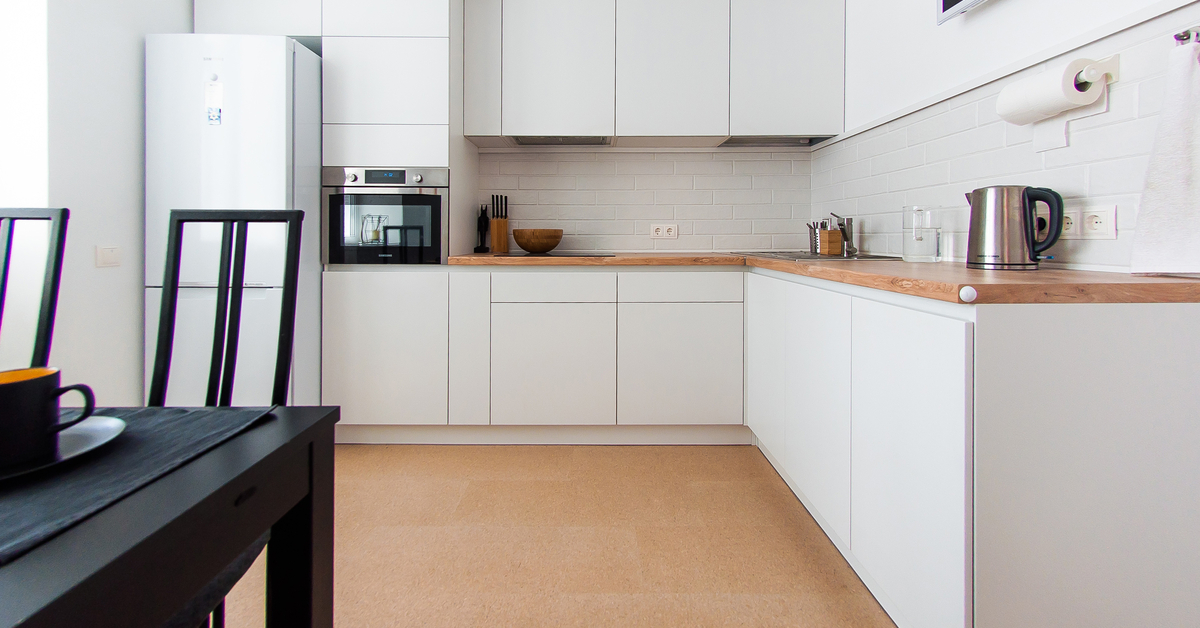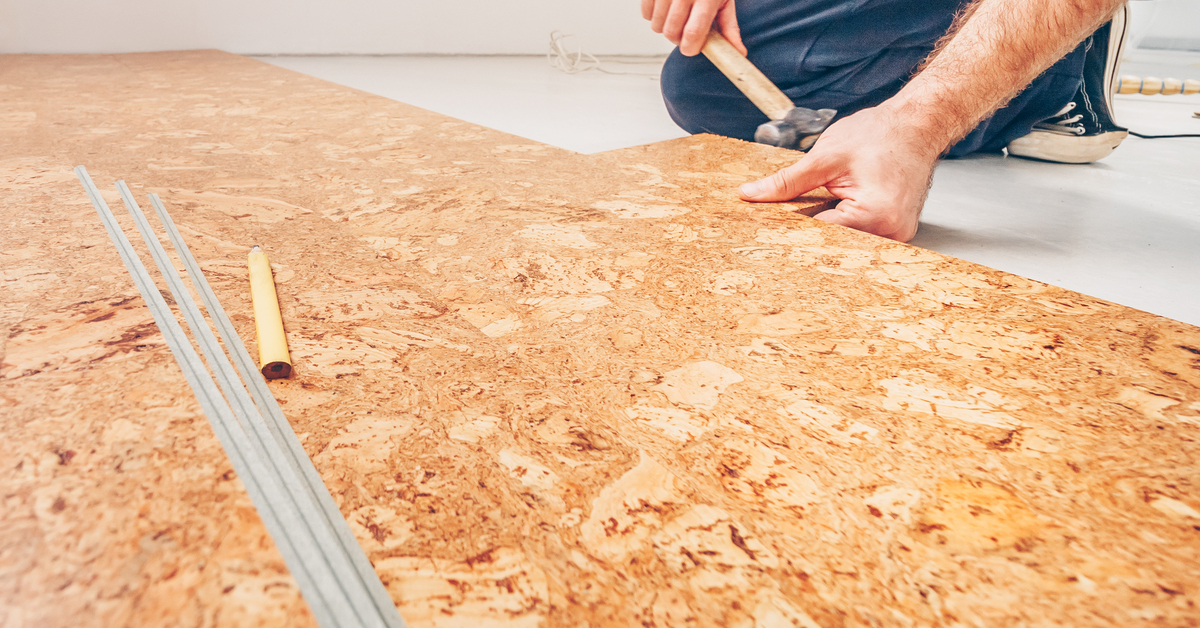Alternative type of flooring surface that is rare in average home is cork. We rarely think about it and many of us didn’t even know it could be used as a flooring material at home.
Cork floors are getting popular in United States because of its quality and advantages over traditional hardwood or tiles. This green and reusable material is very durable but soft at the same time. It can work as an insulator as well as cozy flooring surface, which many home owners are starting to fall in love with.
Although thinner layer of cork matts can be used as sound and thermal underlayment for hardwood floors, we encourage our readers to read this post and see pros and cons of cork flooring as actual surface at home.
Here are some points we wanted to cover in this post:
- Pros and Cons of Cork Flooring Material
- Cork Floor Installation Cost and Comparison
- Installation Process
- Where to Buy This Material
- History and Use of Cork Flooring
Tell us more if you have this type of floors at your home. Remodel On Point would love to share your story with our readers.
Pros and cons

To understand if this type of floor is suitable for your home, Remodel On Point created a list of cork flooring pros and cons. Physical qualities and other factors that some home owners may like, while others have different preference.
Cons
Hard to Clean – this material easily absorbs dirt and liquids, thus making it that much harder to clean. Unlike hardwood or tiles, cork floors have spores and may act like sponge.
Not Popular – you may be researching this topic, but cork is not as popular and widely available as other floors. Finding suppliers and installers for it may be a challenge. Matching later on for fixes is even harder.
Easy to Damage – in addition to stains, cork flooring’s another disadvantage is being soft material. Pets can scratch or even tear it up in pieces. Moving furniture can leave marks behind.
Changes Color – within time the top layer of cork floor changes color. Even in perfect condition it will fade in few places while other spots may become slightly darker.
Maintenance – although it’s not hard or costly to maintain corks, the work has to be performed very often. To keep it in good condition, cleaning, sealants and refinishing is required at least once a year.
Pros
Easy to Install – if you cannot find contractor for installation of want to save some money, cork floors are easy to do on your own. With our help and manufacturer’s instructions every home owner should be able to install cork floors in few days.
Eco-Friendly – materials used for manufacturing are eco-friendly or as some call it green. Disposal after demolition is also directly into recycling.
Reduces Noise – cork floors act as sound barrier and absorb noise very well. We often see cork matts installed even as sub layer for hardwood to sound insulate and reduce noise between floors.
Heat Insulator – this type of material is definitely one of the nicest to walk on. It is super cozy and pleasant to touch. It never gets cold like tiles and does not react to change of temperature like hardwood.
Easy to Replace or Maintain – In case you decide to replace newly installed cork floors it won’t take long time or be costly. Simply remove everything from subfloor and put whatever you feel necessary.
Cork Flooring Cost per Square Foot – Compared to Other floors
The biggest question that builders and home owners ask is how much does it cost. We always say that practicality is the main factor but nevertheless everyone has budget in mind they are willing to spend.
The average cost for cork flooring material is $6.2 per square foot. In America contractors charge $3 for installation of cork floors with prep work and cleanup.
It is one of the easiest materials to install of the floor, but contractors increase their prices simply because there aren’t many people that deal with cork materials. Its supply and demand game, and contractors/installers win here.
Putting together costs cork flooring cost per square foot and comparing different floor types we can see that cork floors are not the most expensive. Tiles and engineered hardwood have way more expensive options, but laminate, vinyl and carpet can be on cheaper side.
How to Install New Flooring with Cork Material

We honestly think that installation of cork floors is one of the easiest if not easiest comparing to other materials. Many home owners decide to install cork flooring on their own and save money on contractors. Only few tools are required for work and you can finish a large area in several days.
Before anything gets installed on subfloor contractors always check the level and cleanliness. Walk around the rooms and make sure that no nails stick out or drops of plaster tuck to plywood. Final cleanup and weeping of the floor is mandatory to make sure there won’t be any bumps.
First of all figure out what type of cork will be used on the floor. Typically there are three different shapes used in residential homes.
Wood Looking Tiles – work exactly like laminate floors. It has a click connection although tiles are larger size. Simply click them together and tap with rubber hammer. Install next to the wall and leave very small gaps to cover later on with baseboards. Because tiles are large, installers like to add a little of glue to the bottom. It prevents floors from sliding and separating.
Square Tiles – the idea is very similar to rubber square mats used in home gyms. They have grove connection or so called tooth edges. These cork floors are connected one to another and very rarely secured to subfloor.
Matts or Rolls – installation of cork here is very different. It may be similar to carpet in a way, but instead on nailing it contractors prefer glue. Make sure to connect the edges perfectly or it will look horrible. We always suggest using nontoxic glue for all renovation projects.
Where to Buy – Local Suppliers vs Online
In this topic we have already mentioned that most of production of cork is in Europe but America is catching up really fast.
Finding local supplier with quality material and reasonable prices is the best option. For buyers it means a lot if they can visit the store and hold the product in hand before paying thousands of dollars for order. This however is a unique material and smaller cities would not have it.
Regional or national floor suppliers are the second option from home owners. You want to make sure reputable company within the country stands behind the order and there is someone you can call in case things go south. In the battle of cork flooring pros and cons, local suppliers always get more advantage.
Cork floors are widely available through online purchasing, but it is the last source we recommend going with. Biggest issues contractors and builders mention are returns and damages of product. Its almost impossible to return a container of floors that seem different from what was ordered through online.
History of Cork Floors
Cork was popular construction material in Europe during 13th-15th centuries. It was used as layer of insulation in ships, construction thermal material and in other implementation. Although it was hard to harvest, the qualities of cork were largely appreciated and many started experimenting with it.
Mass production was still not cheap and cork was used only for necessary construction that could not be supplemented with other materials. We know that few wealthy individuals in Europe had cork floors in separate rooms during 16th – 17th century. It was not practical, but extremely fancy at the time.
Fancy cork floors became popular material for homes in 20th century. In colder countries and regions it was one of the ways to make insulated and slightly warmer floor surface. Even now we see cork being used in remote rooms more than in entire houses.






